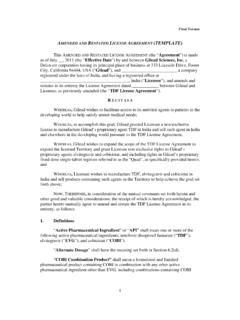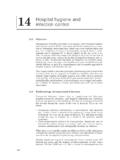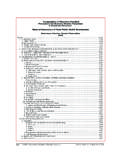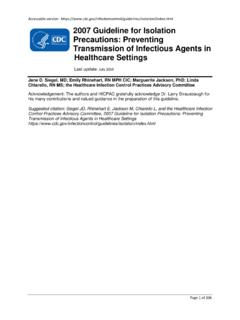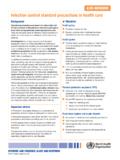Transcription of HIGHLIGHTS OF PRESCRIBING INFORMATION Recommended …
1 1 HIGHLIGHTS OF PRESCRIBING INFORMATION These HIGHLIGHTS do not include all the INFORMATION needed to use truvada safely and effectively. See full PRESCRIBING INFORMATION for truvada . truvada (emtricitabine/tenofovir disoproxil fumarate) tablets, for oral use Initial Approval: 2004 WARNING: POSTTREATMENT ACUTE EXACERBATION OF HEPATITIS B and RISK OF DRUG RESISTANCE WITH USE OF truvada FOR PRE-EXPOSURE PROPHYLAXIS (PrEP) IN UNDIAGNOSED EARLY HIV-1 INFECTION See full PRESCRIBING INFORMATION for complete boxed warning. truvada is not approved for the treatment of chronic hepatitis B virus (HBV) infection. Severe acute exacerbations of hepatitis B have been reported in patients coinfected with HIV-1 and HBV who have discontinued truvada . Therefore, hepatic function should be monitored closely in HBV-infected patients who discontinue truvada . If appropriate, initiation of anti-hepatitis B therapy may be warranted.
2 ( ) truvada used for a PrEP indication must only be prescribed to individuals confirmed to be HIV-negative immediately prior to initial use and periodically during use. Drug-resistant HIV-1 variants have been identified with the use of truvada for a PrEP indication following undetected acute HIV-1 infection. Do not initiate truvada for a PrEP indication if signs or symptoms of acute HIV infection are present unless negative infection status is confirmed. ( ) ----------------------------RECENT MAJOR CHANGES-------------------------- Boxed Warning, Lactic Acidosis/Severe Hepatomegaly with Steatosis Removed 04/2017 Indications and Usage, Treatment of HIV-1 infection ( ) 04/2017 Warnings and precautions , Lactic Acidosis/Severe Hepatomegaly with Steatosis ( ) 04/2017 Warnings and precautions , Coadministration with Other Products ( ) 04/2017 Warnings and precautions , Fat Redistribution Removed 04/2017 -------------------------------INDICATIO NS AND USAGE------------------------- truvada is a combination of EMTRIVA and VIREAD, both nucleoside analog HIV-1 reverse transcriptase inhibitors.
3 truvada is indicated in combination with other antiretroviral agents for the treatment of HIV-1 infection in adults and pediatric patients weighing at least 17 kg. (1) truvada is indicated in combination with safer sex practices for pre-exposure prophylaxis (PrEP) to reduce the risk of sexually acquired HIV-1 in adults at high risk. (1) ------------------------DOSAGE AND ADMINISTRATION---------------------- Treatment of HIV-1 Infection ( ) Recommended dose in adults and pediatric patients weighing greater than or equal to 35 kg: One truvada tablet (containing 200 mg/300 mg of emtricitabine and tenofovir disoproxil fumarate) once daily taken orally with or without food. ( ) Recommended dose in pediatric patients weighing greater than or equal to 17 kg and able to swallow a whole tablet: one truvada low-strength tablet (100 mg/150 mg, 133 mg/200 mg, or 167 mg/250 mg based on body weight) once daily taken orally with or without food.
4 ( ) Recommended dose in renally impaired HIV-1 infected adult patients : o Creatinine clearance 30 49 mL/min: 1 tablet every 48 hours. ( ) o CrCl below 30 mL/min or hemodialysis: Do not use truvada . ( ) Pre-exposure Prophylaxis ( ) Recommended dose in HIV-1 uninfected adults: One tablet (containing 200 mg/300 mg of emtricitabine and tenofovir disoproxil fumarate) once daily taken orally with or without food. ( ) Recommended dose in renally impaired HIV-uninfected individuals: Do not use truvada in HIV-uninfected individuals if CrCl is below 60 mL/min. If a decrease in CrCl is observed in uninfected individuals while using truvada for PrEP, evaluate potential causes and re-assess potential risks and benefits of continued use. ( ) -----------------------DOSAGE FORMS AND STRENGTHS-------------------- Tablets: 200 mg/300 mg, 167 mg/250 mg, 133 mg/200 mg, and 100 mg/150 mg of emtricitabine and tenofovir disoproxil fumarate, respectively.
5 (3) --------------------------------CONTRAIN DICATIONS------------------------------ Do not use truvada for pre-exposure prophylaxis in individuals with unknown or positive HIV-1 status. truvada should be used in HIV-infected patients only in combination with other antiretroviral agents. (4) -------------------------WARNINGS AND precautions ---------------------- New onset or worsening renal impairment: Can include acute renal failure and Fanconi syndrome. Assess estimated creatinine clearance before initiating treatment with truvada . In patients at risk for renal dysfunction, assess estimated creatinine clearance, serum phosphorus, urine glucose, and urine protein before initiating treatment with truvada and periodically during treatment. Avoid administering truvada with concurrent or recent use of nephrotoxic drugs. ( ) Lactic acidosis/severe hepatomegaly with steatosis: Discontinue treatment in patients who develop symptoms or laboratory findings suggestive of lactic acidosis or pronounced hepatotoxicity.
6 ( ) Coadministration with other products: Do not use with drugs containing emtricitabine, tenofovir alafenamide, or tenofovir disoproxil fumarate including ATRIPLA, COMPLERA, EMTRIVA, DESCOVY, GENVOYA, ODEFSEY, STRIBILD, VEMLIDY, VIREAD; or with drugs containing lamivudine. Do not administer in combination with HEPSERA. ( ) Decreases in bone mineral density (BMD): Consider assessment of BMD in patients with a history of pathologic fracture or other risk factors for osteoporosis or bone loss. ( ) Immune reconstitution syndrome: May necessitate further evaluation and treatment. ( ) Triple nucleoside-only regimens: Early virologic failure has been reported in HIV-infected patients . Monitor carefully and consider treatment modification. ( ) Comprehensive management to reduce the risk of acquiring HIV-1: Use as part of a comprehensive prevention strategy including other prevention measures; strictly adhere to dosing schedule.
7 ( ) Management to reduce the risk of acquiring HIV-1 drug resistance: o Prior to initiating truvada for PrEP if clinical symptoms consistent with acute viral infection are present and recent (<1 month) exposures are suspected, delay starting PrEP for at least one month and reconfirm negative HIV-1 status or use a test approved by the FDA as an aid in the diagnosis of HIV-1 infection, including acute or primary HIV-1 infection. o While using truvada for PrEP HIV-1 screening tests should be repeated at least every 3 months. ( ) --------------------------------ADVERSE REACTIONS----------------------------- In HIV-1 infected patients , the most common adverse reactions (incidence greater than or equal to 10%) are diarrhea, nausea, fatigue, headache, dizziness, depression, insomnia, abnormal dreams, and rash. ( ) In HIV-1 uninfected individuals in PrEP trials, adverse reactions that were reported by more than 2% of truvada subjects and more frequently than by placebo subjects were headache, abdominal pain, and weight decreased.
8 ( ) To report SUSPECTED ADVERSE REACTIONS, contact Gilead Sciences, Inc. at 1-800-445-3235 or FDA at 1-800-FDA-1088 or ---------------------------------DRUG INTERACTIONS---------------------------- - Didanosine: Tenofovir disoproxil fumarate increases didanosine concentrations. Use with caution and monitor for evidence of 2 didanosine toxicity ( , pancreatitis, neuropathy) when coadministered. Consider dose reductions or discontinuations of didanosine if warranted. ( ) HIV-1 protease inhibitors: Coadministration decreases atazanavir concentrations and increases tenofovir concentrations. When coadministered with truvada , use atazanavir given with ritonavir. Coadministration of truvada with atazanavir and ritonavir, darunavir and ritonavir, or lopinavir/ritonavir increases tenofovir concentrations. Monitor for evidence of tenofovir toxicity. ( ) ---------------------------USE IN SPECIFIC POPULATIONS-------------------- Nursing mothers: Women infected with HIV-1 should be instructed not to breastfeed.
9 ( ) See 17 for PATIENT COUNSELING INFORMATION and Medication Guide. Revised: 04/2017 FULL PRESCRIBING INFORMATION : CONTENTS* WARNING: POSTTREATMENT ACUTE EXACERBATION OF HEPATITIS B and RISK OF DRUG RESISTANCE WITH USE OF truvada FOR PRE-EXPOSURE PROPHYLAXIS (PrEP) IN UNDIAGNOSED EARLY HIV-1 INFECTION 1 INDICATIONS AND USAGE Treatment of HIV-1 Infection Pre-Exposure Prophylaxis 2 DOSAGE AND ADMINISTRATION Recommended Dose for Treatment of HIV-1 Infection in Adults and Pediatric patients Weighing 35 kg or More Recommended Dose for Treatment of HIV-1 Infection in Pediatric patients Weighing at Least 17 kg and Able to Swallow a Whole Tablet Recommended Dose for Pre-exposure Prophylaxis Dose Adjustment for Renal Impairment 3 DOSAGE FORMS AND STRENGTHS 4 CONTRAINDICATIONS 5 WARNINGS AND precautions HBV Infection New Onset or Worsening Renal Impairment Lactic Acidosis/Severe Hepatomegaly with Steatosis Coadministration with Other Products Bone Effects of Tenofovir DF Immune Reconstitution Syndrome Early Virologic Failure Comprehensive Management to Reduce the Risk of Acquiring HIV-1 6
10 ADVERSE REACTIONS Adverse Reactions from Clinical Trials Experience in HIV-1 Infected Subjects Adverse Reactions from Clinical Trial Experience in HIV-1 Uninfected Adult Subjects Postmarketing Experience 7 DRUG INTERACTIONS Didanosine HIV-1 Protease Inhibitors Hepatitis C Antiviral Agents Drugs Affecting Renal Function 8 USE IN SPECIFIC POPULATIONS Pregnancy Nursing Mothers Pediatric Use Geriatric Use patients with Impaired Renal Function 10 OVERDOSAGE 11 DESCRIPTION 12 CLINICAL PHARMACOLOGY Mechanism of Action Pharmacokinetics Microbiology 13 NONCLINICAL TOXICOLOGY Carcinogenesis, Mutagenesis, Impairment of Fertility Animal Toxicology and/or Pharmacology 14 CLINICAL STUDIES Study 934 iPrEx Trial Partners PrEP Trial 16 HOW SUPPLIED/STORAGE AND HANDLING 17 PATIENT COUNSELING INFORMATION * Sections or subsections omitted from the full PRESCRIBING INFORMATION are not listed 3 FULL PRESCRIBING INFORMATION WARNING: POSTTREATMENT ACUTE EXACERBATION OF HEPATITIS B and RISK OF DRUG RESISTANCE WITH USE OF truvada FOR PRE-EXPOSURE PROPHYLAXIS (PrEP) IN UNDIAGNOSED EARLY HIV-1 INFECTION truvada is not approved for the treatment of chronic hepatitis B virus (HBV) infection, and the safety and efficacy of truvada have not been established in patients coinfected with HBV and HIV-1.






